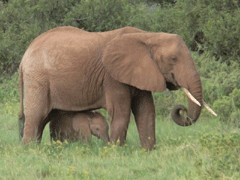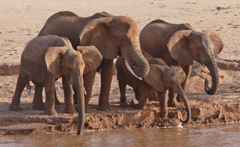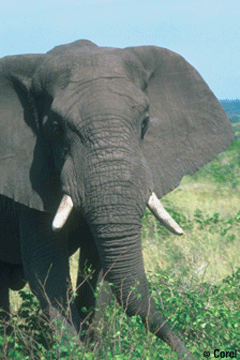Endangered Elephants
Air Date: Week of March 30, 2007

Male baby elephants stay with their mothers until they are about 14. Females live in a familial group with their mothers, grandmothers, sisters and aunts their entire lives. (Courtesy of Richard A. Muller/Lawrence National Laboratory)
Twenty years after an international treaty banning the trade of ivory, ivory smuggling is alive and well. Samuel Wasser of the Center for Conservation Biology at the University of Washington tells host Steve Curwood why the 1989 ban on ivory has failed and what can be done to end the slaughter of the world’s largest terrestrial mammal.
Transcript
GELLERMAN: It’s Living on Earth I’m Bruce Gellerman.
[ELEPHANT CALL]
GELLERMAN: This is the trumpet of an elephant, the world’s largest terrestrial mammal. Listen well because the sound may be lost to future generations. Nearly 20 years after the world came together to ban the international trade of ivory, ivory smuggling is back, big time, and so is the poaching of African elephants. In 2002, officials confiscated 13 thousand pounds of ivory in a single raid, but authorities say the only thing unusual about that incident was that the smugglers were caught. As much as 90 percent of smuggled ivory is never seized.
Samuel Wasser is the director of the Center for Conservation Biology at the University of Washington in Seattle. He recently spoke with Living on Earth’s Steve Curwood about the resurgence of the ivory trade.
WASSER: Actually it is not illegal to sell ivory in any country right now. There was a ban against the sale of ivory in 1989 by the Convention of International Trade and Endangered Species, which is the United Nations entity. But what that really bans is you selling ivory across an international border. So you can buy it on e-bay. You can go into Chinatown in most big cities here and find ivory and it’s all perfectly legal.

Pratt, Read and Company weigh an ivory tusk circa 1955. (Courtesy of the Town of Essex, CT)
CURWOOD: So when the ban uh on ivory came back in 1989, this was hailed by conservationists as stopping massive elephant slaughter. Now as I understand it things are as bad if not worse than they were back in 1989. What’s happened?
WASSER: Well, first of all you’re absolutely correct that in 1989, when the ban first went into effect in 1989 it was probably the single most effective act of wildlife legislation ever. People were up in arms and they stopped poaching almost over night. And then by about 1993 Western aid realized that they had the problem under control or thought they did and they withdrew the aid. But what really happened that was the clincher was the economies in the Far East began to grow, especially the middle class in China and also in Japan. And this created an insatiable desire to own ivory because it was a sign of prestige and that you have achieved wealth.
What this did was it caused the price of ivory to rise substantially in recent years. In the late 1990s the price of ivory was 100 dollars a kilo and last week it went up to 850 dollars a kilo.
CURWOOD: Talk to me about what this is doing to the elephants. Ah, as I understand it more and more research is showing that elephants respond to this massive poaching and killing much the way that people would.
WASSER: Absolutely. Some of your listeners may have heard of the elephant graveyards. Well, of course that’s fantasy. But what is not fantasy and where that myth came from is elephants have a incredible interest in their dead. There’s story after story of elephants who have died and the other elephants just stand around it for hours even days, incredibly distressed.
When elephants are being poached so heavily one of the things that happens is first they poach the large bulls because they have the largest tusks. And then they go to the next largest tusked animal, which is the matriarch, the big female which is in charge of the whole social integrity of their group. And as they kill these old matriarchs the younger ones are becoming very distressed just from killing of their family members but also so much knowledge is lost when you loose these old females. For example if you have drought occurring every twenty years or so that may require you to use resources that you only used every twenty years. And if the animals that know where those resources are, are now dead, you can’t get there.

Elephant families like this one, taking a drink at Samburu National Reserve in Kenya, are lead by a matriarch and live their entire lives together as a family unit. (Courtesy of Richard A. Muller/Lawrence National Laboratory)
CURWOOD: How is it that the poachers kill these elephants. What do they do to them?
WASSER: During the poaching heyday we saw so many dead elephants all the time and you could tell they had been poached because their face was chopped off. People they kill the elephant and then they take a big ax and they chop the face off so that they can pull out the tusks. And we found one elephant that still had its tusks and we though, “ah finally an elephant that died that’s not from a poacher.” And I was in the field there for many many months there and passed that elephant time and time again as it decayed. And when it decayed one day I was looking at it and I saw a piece of rebar in there. And then I realized that that animal had been poached. It just didn’t die right away. It wandered and had a very slow horrible death.

An African Elephant (Courtesy of USFWS)
CURWOOD: So, going back to this 1989 ban on trading, elephant populations went up and were doing pretty well, but now we’re back to a situation where what, almost ten percent of the elephant population is being killed every year at this point. What happened?
WASSER: Well, first of all it’s not true that the elephant populations went up. Because this is a big animal rights issue of having to kill entire herds of elephants that’s what’s been in the news for so long and this has created a false impression that there are too many elephants around the continent. The reason that there are so many elephants in South Africa is that the South African soldiers were up in Mozambique fighting guerrilla insurgents. And 60,000 elephants were killed in that time. The elephants from Mozambique made a beeline down to South Africa and they put up a fence around Kruger National Park. And meanwhile the park has 300 artificial waterholes throughout the park so tourists can see wildlife no matter where they go.
CURWOOD: Mmm hmm

Male baby elephants stay with their mothers until they are about 14. Females live in a familial group with their mothers, grandmothers, sisters and aunts their entire lives. (Courtesy of Richard A. Muller/Lawrence National Laboratory)
WASSER: Elephants self regulate their numbers by drought. When there’s a drought they stop reproducing. Well, in South Africa they don’t experience a drought when it occurs because there’s artificial waterholes everywhere. So they can’t self regulate their numbers and the whole area that they live in is enclosed. So when they’re crying that we need to cull our elephants because there’s too many of them. What they really need is to take the fences down and get rid of the artificial waterholes. And there is some very clever work being proposed by Rudy Van Arden in South Africa to create these mega-parks trans-boundry parks, where elephants are able to roam across several different countries. And there’s tons of habitat there for them to do that and it would be a cooperatively managed entity and that would solve these kinds of problems.
CURWOOD: So, there’s this call to cull quote “overpopulated elephants.” How is this done and how does this affect the elephants who are left behind?
WASSER: What they need to do is they need to cull entire family groups. If they kill just the adults the young are going to be orphaned and many will die quite a horrible death. What they do is they take helicopters and they fly over the herds of elephants and then the entire family stays really close together, close knit, and they move out of the herd and start to run away. And so now they know that they’ve got an intact family and then they fly over and they kill them all.
One of the big concerns about this is that the family groups that stay together in the tightest knit groups are the ones that are being killed. So it potentially is selecting for socially dysfunctional elephants.
CURWOOD: So, what is the solution to the elephant problem? I mean it seems that you either have too many in one place or too few in another.
WASSER: What we really need is to close down the ivory trade. In 1989 when the ivory ban went into effect we had a massive infusion of law enforcement in Africa that stopped poaching virtually over night. We can do that again very easily. What we’re talking about in each country are buying them 25 new vehicles, um new guns and ammunition, and new boots. At the same time the very small number of countries that have too many elephants right now in a compressed area need to be encouraged to start doing the kinds of wildlife management that will allow these elephants to once again self regulate themselves.
And lastly what is really important is to educate people in the Far East to start using alternatives besides ivory. And one of the things that we are proposing there is to get celebrities in the Far East to start coming out against usage of ivory. There was just a very very successful initiative by Wild Aid to stop the purchasing of shark fins in China. They got a very famous Chinese basketball player to come out against it. This kind of thing is remarkably effective in getting people to reevaluate their desires.
GELLERMAN: Samuel Wasser is the director of the Center for Conservation Biology at the University of Washington in Seattle. He spoke with Living on Earth’s Steve Curwood
[MUSIC: Nils Petter Molvaer “Kakonita” from ‘Solid Ether’ (ECM Records – 2000)]
Links
Center for Conservation Biology at the University of Washington
Living on Earth wants to hear from you!
Living on Earth
62 Calef Highway, Suite 212
Lee, NH 03861
Telephone: 617-287-4121
E-mail: comments@loe.org
Newsletter [Click here]
Donate to Living on Earth!
Living on Earth is an independent media program and relies entirely on contributions from listeners and institutions supporting public service. Please donate now to preserve an independent environmental voice.
NewsletterLiving on Earth offers a weekly delivery of the show's rundown to your mailbox. Sign up for our newsletter today!
 Sailors For The Sea: Be the change you want to sea.
Sailors For The Sea: Be the change you want to sea.
 The Grantham Foundation for the Protection of the Environment: Committed to protecting and improving the health of the global environment.
The Grantham Foundation for the Protection of the Environment: Committed to protecting and improving the health of the global environment.
 Contribute to Living on Earth and receive, as our gift to you, an archival print of one of Mark Seth Lender's extraordinary wildlife photographs. Follow the link to see Mark's current collection of photographs.
Contribute to Living on Earth and receive, as our gift to you, an archival print of one of Mark Seth Lender's extraordinary wildlife photographs. Follow the link to see Mark's current collection of photographs.
 Buy a signed copy of Mark Seth Lender's book Smeagull the Seagull & support Living on Earth
Buy a signed copy of Mark Seth Lender's book Smeagull the Seagull & support Living on Earth

